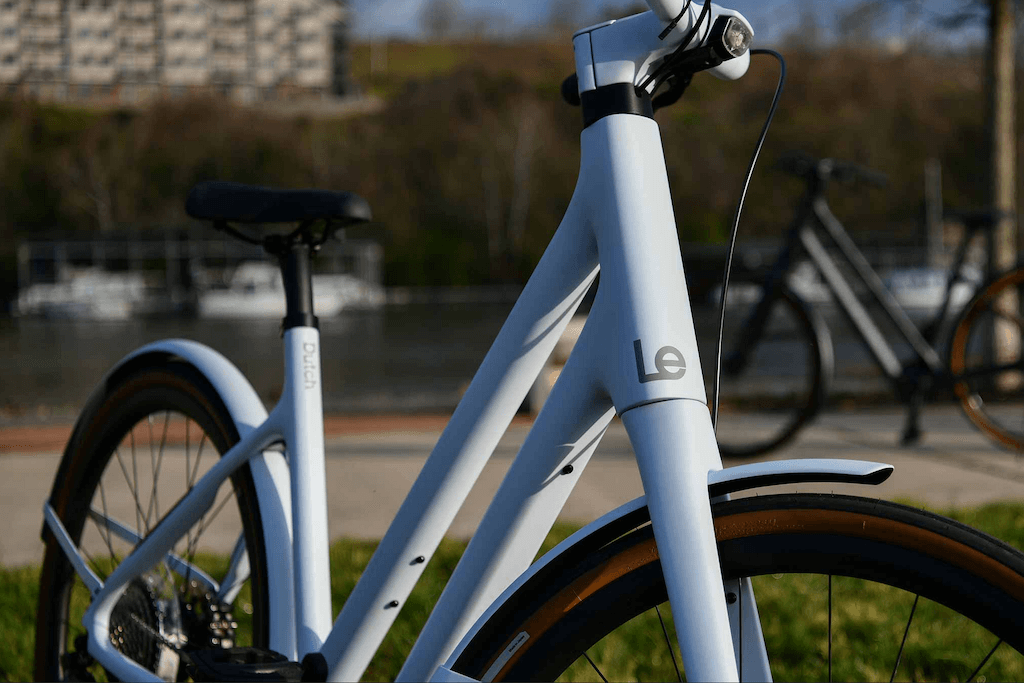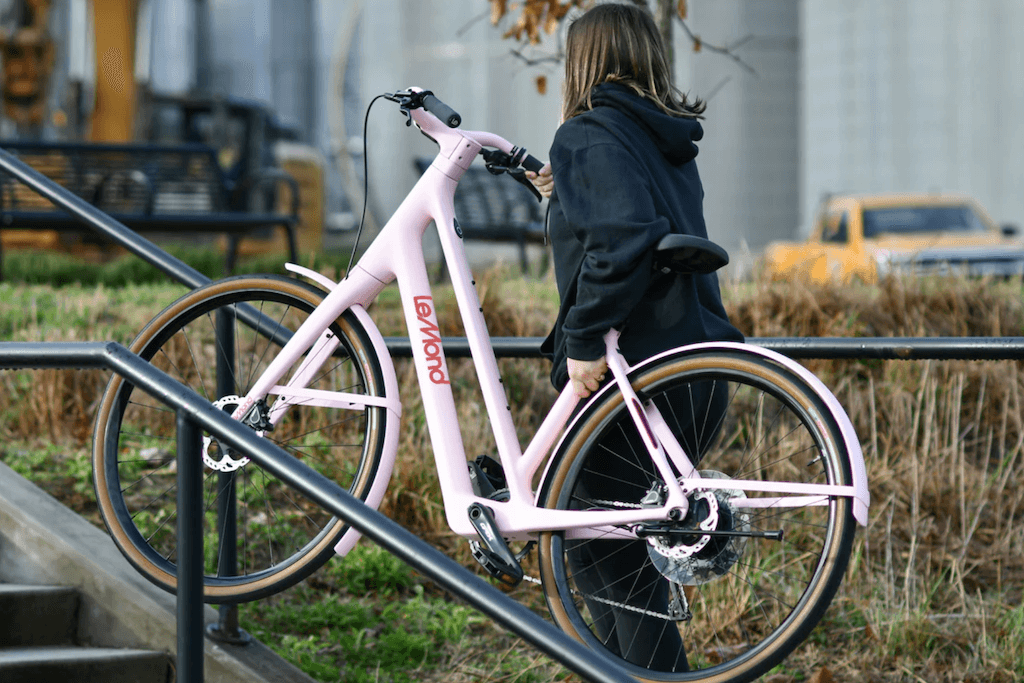Autumn Gear Guide
Find inspiration in our Gear Guide that will keep you out on your bike through wind or rain.
Download NowReview: LeMond Dutch By Robert Isenberg As the FedEx truck pulled away, I grabbed the cardboard box by its handholds and pulled—and to my amazement, the whole package moved, easily. Halfway to the garage, I stopped dragging the box and just lifted it across the lawn. Why so light? Because the LeMond Dutch is constructed […]
Review: LeMond Dutch
By Robert Isenberg
As the FedEx truck pulled away, I grabbed the cardboard box by its handholds and pulled—and to my amazement, the whole package moved, easily. Halfway to the garage, I stopped dragging the box and just lifted it across the lawn.
Why so light? Because the LeMond Dutch is constructed mostly out of carbon fiber. This is the first thing you will hear about LeMond products: carbon frames and forks make these machines incredibly light, not just for e-bikes but for any kind of bike. At 27 pounds (12.2 kg), even I, with my unexceptional biceps, can hold this thing over my head with one hand.
Nearly as buzzworthy as the e-bike itself is its founder: Greg LeMond is one of the greatest U.S. cycling champions in racing history, who has risen above both scandal and post-retirement obscurity to become a celebrated entrepreneur. LeMond has proven to be a rare bird: a celebrity athlete who wants regular people to enjoy bicycles as much as he does. Yet the Dutch isn’t a racing bike; it’s modeled on the eponymous “Dutch” design, with upright seating, curved handlebars, and such a simple interface that passersby might not even know it’s electric.
That said, the Dutch does cost about $5,500 as a result of its cutting-edge design and carbon materials. Virtually no one will buy this on a whim, nor should they. This is a lifestyle investment. But how does it perform?
The e-bike industry practically boils with imagination, and complex new designs can look like something out of a Batman movie. The Dutch goes in the opposite direction: It’s sleek and understated, the portrait of elegant simplicity. The Dutch comes in only three solid colors: black, pink, and baby blue. There’s no digital display. The tires are lean and smooth. Any trace of the battery is invisible.

The LeMond engineers have cleverly figured out how to control every facet of an e-bike with a single button, which is embedded in the top tube. The ring around the button turns different colors, indicating different settings. You can technically pair the bike with your smartphone, thanks to a Bluetooth option, but lots of riders will appreciate its no-fuss functionality. Once you’ve mastered the button, riding the Dutch becomes pure instinct, no screen required.
The Dutch also boasts a sleek integrated lighting system and an 11-speed Shimano GRX drivetrain.
The most unique feature is also its most fundamental: If you run out of battery, the Dutch is light enough to just manually pedal around. Most be-ikes are too cumbersome to operate without the aid of a motor; the Dutch is a pleasure. The drivetrain boasts 11 speeds, an unusually high number for any e-bike, and riders need not rely on the Dutch’s four levels of pedal assist.
At 27 pounds, the Dutch, which is no small machine, is one of the lightest e-bikes on the market. There are folding e-bikes half the size that weigh-in at a similar heft and boast of being lightweight.
So, why is this particular e-bike so expensive? In short, the Dutch is so valuable because of its carbon fiber frame. This is an inherently expensive substance to process, and the pricing is actually pretty competitive.
Carbon bicycles are nothing new, but it is usually in the categories where weight matters most: road bikes, and mountain bikes. For instance, the Specialized S-Works Tarmac SL7 retails for more than $14,000. Of course, there is now a Porsche e-bike that retails for $15,000 and it just uses plain old aluminum.
LeMond also has a flat-bar style Prolog model.
Still, if a super-light ride isn’t your top priority, the Dutch may strike you as overkill. But, it is worth testing out and experiencing before making that decision. This weight could be a game-changer for a lot of riders who are put off by the weight of some e-bikes that routinely clock in at 50+ pounds. At that weight, any stairs are a chore. Run out of battery before that final hill home? Forget about it.
In fact, this bike could have great utility for older riders who just can’t deal with the excessive weight of other e-bikes on the market.
The Dutch asks a lot of its rider. Like Apple computers and Rolex watches, LeMond has a certain design philosophy, and it carries through all facets of the operation. For example, you can’t remove the battery, which means you have to plug the bike directly into an electrical socket. This isn’t the end of the world, given how nimble the bike is, but you may have to get creative in certain situations. The lack of a built-in screen, which many e-bike riders have come to expect, means there’s no real-time data for speed and mileage, unless you also use a separate device. Of course, the Dutch isn’t built for speed. It’s built for style and substance.
Speaking of speed, the pedal assist tops out at 20 mph (35 kph), which is typical but hardly the fastest an e-bike can legally go. Many riders will find this speed limit restrictive when compared to other bikes, especially when Greg LeMond himself set a time trial speed record at the 1989 Tour de France. Again, the LeMond company isn’t in the business of racing bikes, but if you expect $5,500 to translate into superhuman velocity, the Dutch is not your ride.
Finally, the Dutch is not the all-terrain vehicle that many e-bikes aspire to be. This bike has no shocks or heavy tires, so it’s clearly meant for paved surfaces. This is a city bike through and through. One designed for commuting and for neighbourhood jaunts.
There’s nothing wrong with that; the Netherlands has rapidly popularized the idea of functional urban cycling, and the Dutch dutifully follows in that tradition.

Riding the LeMond Dutch is a beautiful experience. Many critics have said this before, describing the buttery roll of the Dutch in lyrical prose, and I agree with all of them. In an ideal world, every living person would have the chance to ride one. The comfy seat, the smooth gears, the gentle pedal assist, the ergonomic geometry—they all add up to a blissful glide.
The ideal user is willing to splurge on luxury but also prefers a streamlined experience. The Dutch is a fantastic commuter, especially in cities, and you may find yourself taking the scenic route in order to ride it as long as possible. Because this bike encourages such upright posture, you can ride around and explore for hours without tiring. This is a machine designed for small neighborhoods and quaint villages, with plenty of stops and spontaneity along the way.
It must be said that the LeMond brand is a natural conversation-starter, and you may get a lot of stares from strangers. Owning a Dutch basically invites long conversations about the benefits of carbon fiber, which is not only a featherweight material but also strong, tensile, and weather-resistant. For those in the know, the Dutch is something of a status symbol, and you may win a lot of envy; you may also attract a legion of bike thieves, so please, please get this thing insured.
Keep in mind that a quality bike will last for decades. This e-bike is crafted not just manufactured. As more and more people commute by e-bike, replacing luxury cars with luxury velocipedes, high-quality machines like the Dutch may find themselves ahead of the curve. No one ever questions the sight of a Porsche or Tesla on the freeway. The Dutch is an indulgence we can get behind.
Find inspiration in our Gear Guide that will keep you out on your bike through wind or rain.
Download Now
Leave a comment